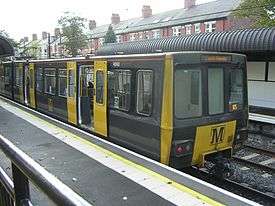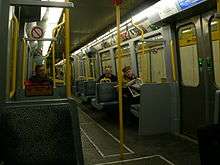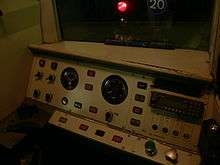Tyne and Wear Metro rolling stock
| Tyne & Wear Metrocar (British Rail Class 994) | |
|---|---|
 Tyne and Wear Metro train 4060 at Ilford Road | |
.jpg) Interior of Tyne & Wear Metrocar | |
| Manufacturer | Metro-Cammell |
| Built at | Washwood Heath, Birmingham |
| Constructed | 1975, 1978-81 |
| Entered service | 1980 |
| Refurbishment | Jun 2010 - Jul 2015 |
| Number built | 90 trainsets |
| Number in service | 90 trainsets |
| Formation | 2 cars per trainset, 4 cars per train |
| Fleet numbers |
994001 - 994090 (TOPS) 4001 - 4090 (TWM) |
| Capacity | 68 seats, 232 standing |
| Operator(s) | Tyne and Wear Metro |
| Depot(s) | Metro Fleet Depot, Gosforth |
| Line(s) served | Green and Yellow |
| Specifications | |
| Car body construction | Aluminum and steel |
| Car length | 27.8 m |
| Width | 2650 mm |
| Height | 3445 mm |
| Doors | 2 sets of double doors per car, at 1/3 and 2/3 |
| Maximum speed | 50 mph (80 km/h) |
| Weight | 39 metric tonnes |
| Electric system(s) | 1500V DC Overhead lines |
| Current collection method |
Pantograph Type: Brecknell Willis High Reach |
| Multiple working | Trains mainly operate in pairs, however on rare occasions operate individually. Unused ability to run in sets of 3 or 4. |
| Track gauge | 1435 mm (4 ft 8½ in) |
The Tyne and Wear 'Metrocar' (British Rail Class 994) serves the Tyne and Wear Metro, a light rail system in North East England, serving Newcastle upon Tyne, Gateshead, South Tyneside, North Tyneside and Sunderland. Since the inception of the Metro the rolling stock has remained the same. The 90 train fleet have been refurbished a number of times, with various liveries. Full refurbishment of the fleet took place between 2010 and 2015. Metrocars have been refurbished by Wabtec Rail at its Doncaster facility with the main goal of the project to extend their service life until 2025.[1]
Design


The design of the Metrocars was partly derived from that of the German Stadtbahnwagen B, although the Metrocars were built by the now-defunct Metro-Cammell in Birmingham (now part of Alstom) and were not fitted with the lights and indicators that would have allowed them to run on city streets. Prior to opening, the Metro's two prototypes, 4001 and 4002, still in service, underwent several years of testing at the Metro's test track on North Tyneside, opened in 1975.
The sets each consist of two semi-permanently connected cars mounted on three bogies. The outermost bogies are powered, with the centre bogie being articulated between both cars. The trains make use of resistive braking, with air-operated disc brakes for use during the final stages of deceleration. All bogies are equipped with a pair of magnetic track-brakes, which can be used to bring a train to a complete stand in as little as 150m from the maximum service speed.
The prototype cars were very similar to the production fleet with the exception of their Kiekert passenger doors which were refitted to match the specification of the production fleet before entering revenue service. The main differences included the use of a "bow" style pantograph, a door in the front and back ends of the trains, and the lack of an external door serving the drivers cab. The prototype cars were also fitted with two different types of block coupling equipment (one at each end), allowing the two designs to be thoroughly tested. Prior their entry into service the prototypes were converted to reflect the specification of the production fleet.
The track was also used to test cars for the Hong Kong MTR, also built by Metro-Cammell. To accommodate the larger Hong Kong cars a short above-ground test tunnel had to be demolished. The test track was built on the route of an old mineral wagonway, and it is now home to the Stephenson Railway Museum.
Including the two prototype trains, a total of 90 two-car sets were constructed (the original specification for the system stated 120 trains, but this number was cut back due to funding problems). All 90 of the trains are still in operation today.
The units are allocated TOPS numbers 994001-90, for use when working on the section between Pelaw Junction and South Hylton - which is owned and operated by Network Rail. They also have different horn sounds, as they have been updated on some Metrocars throughout the years of their life.

Livery


The Metro fleet was initially painted in a two-tone livery of cadmium yellow and white that matched the Metro station design and the livery of the Tyne and Wear bus fleet until 1986. In the mid-1990s a new colour scheme was introduced, solid red, green, or blue with a yellow wedge at each end and yellow triangles on the doors. This scheme was modified slightly in 2005, in part to comply with safety regulations - the doors were changed to solid yellow to comply with the Disability Discrimination Act.
Between 2011 and late 2015 the Metrocars have undergone a refurbishment, they are now black and yellow cadmium Metrocars. 86 of the units will feature the new scheme excluding the four units that were not refurbished. Prototype 4001 has been repainted in its initial yellow-and-beige livery, prototype 4002 carries a full body advert for the Tyne & Wear metro website, and cars 4040 and 4083 carry a full body Emirates livery. Refurbished Metrocars 4082 & 4033 both carry an Emirates livery.
To celebrate the Queen's Golden Jubilee in 2002, unit 4032 was temporarily decorated in a special gold livery. It has since been returned to the red and yellow livery, which it carried until refurbishment
Electrics

The Metro is electrified at 1500 V DC, as previously used on the Woodhead Line but now unique in Britain. The traction equipment onboard Metro trains is wound for a voltage of 600V DC. Each two car Metro set has its own pantograph for collecting power.
Metro has a maximum speed of 80 km/h (50 mph), which it attains on rural stretches of line. The vehicles have a minimum curve radius of 50 m (55 yd), although there are no curves this tight except for the non-passenger chord between Manors and West Jesmond.
Service formations

During the early years of Metro, units were operated in single and double sets.
As single units became overcrowded Nexus resumed using two units as standard.[2] Single units again became common during construction of the Sunderland extension when some units were taken for testing of the new track. During original construction Metro was designed to use three unit sets, and some platforms were constructed to accommodate this, however due to a lack of funding this was not possible. As a result, the units run in sets of two. In the future Nexus was quoted as saying platforms could be extended to accommodate three units, but they will not fit onto some stations' platforms.
Announcements

The "stand clear of the doors please" announcement, which sounded before the doors started to close, was introduced in 1991. In 1996, a contest was held in which several mystery celebrities recorded the phrase, with a prize awarded for correct identification; these recordings were replaced by staff announcements after the contest ended. In order to increase the clarity of the announcement (especially for individuals not fluent in English) the phrase was replaced with "doors closing" in 2004.
In 2011, the "doors closing" recording was replaced in post-refurbishment Metrocars with a simple beeping sound, similar to that of the London Underground. The train emits a solid 3-second beep when the doors are released, and a rapid 3-second beeping immediately before the doors are closed, in line with the 2010 UK Rail Vehicle Accessibility Regulations (RVAR).
When the automated next station announcements were introduced they featured a female announcer, however during late 2014 this was replaced with a male announcer.
Future
Nexus has invested £1.7 million on audio visual display boards on-board its 90 strong fleet of trains to provide station information. Full refurbishment of 86 cars in the fleet has taken place at Wabtec Rail in Doncaster. This commenced June 2010 and was completed in July 2015,[3] extending their life until 2025. The fleet will be over 40 years old by this point, even though the original design life of the trains was only 30 years.
The refit at Wabtec saw the trains undergo corrosion correction work, to repair damage as a result of the trains' steel and aluminum construction, new seating, flooring and interior finish, in addition to improved saloon and emergency lighting. A new larger wheelchair space has also been created at the end of each car, featuring a "call for assistance" device. Other minor modifications include improved door seals, more concise interior signage and removal of the green boarding lamps to facilitate new audio warning equipment for door operation. Some Metrocars also feature air conditioning boxes at their A end to control the conditions within the drivers cab. Passenger counters were integrated above doors to help Nexus analyse trends in passenger levels. These features were removed from the specification midway through the refurbishment however.
Due to budget constraints as a result of the trains being in worse condition than anticipated, a total of 4 sets were not refitted. These will include the converted prototype trains, 4001 and 4002, in addition to 4040 and 4083 from the production fleet. These 4 units, which equate to 2 consists in passenger service formation, are electrically incompatible with the wider fleet for use in revenue service. Nexus has stated that the units which are not refitted will be held in reserve, only seeing use during periods of high demand, for example extra services during the Christmas period or for local sporting fixtures.
References
- ↑ "Company chosen to refurbish Tyne and Wear's 90 Metrocars". prnewswire. Retrieved 2010-06-11.
- ↑ "May 2002 Sunderland Extension". Railway Technology. Retrieved 2007-02-20.
- ↑ "Nexus". Nexus. Retrieved 2015-09-15.